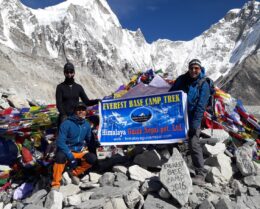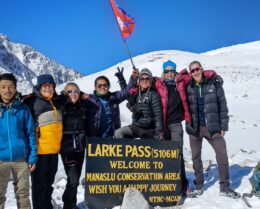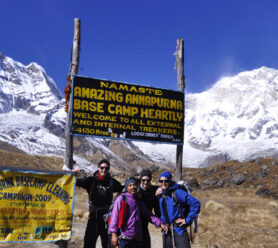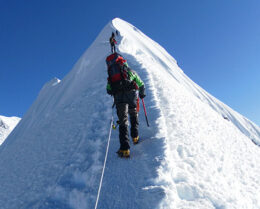Best and Cheapest Treks in Nepal: Ghandruk and Landruk Trek, Mardi, Poonhill
UPDATED ON 22 March, 2024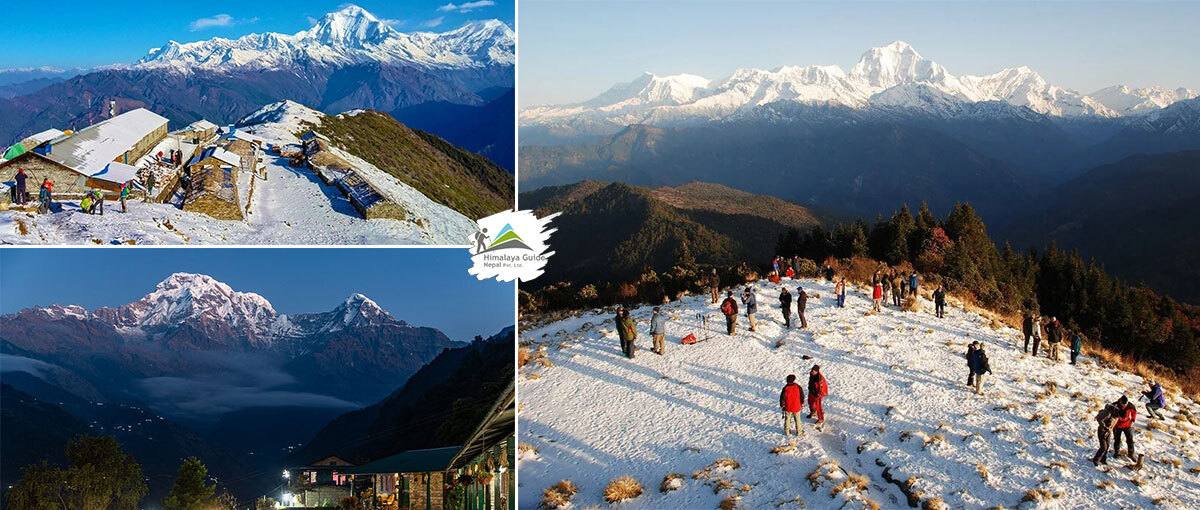
Nepal offers a wide variety of landscapes and civilizations, making it a trekker’s dream destination. There are many best and cheapest Treks in Nepal, that preserve the natural beauty and cultural experience for people on a tight budget. The traditional Poon Hill Trek provides breathtaking vistas of the Dhaulagiri and Annapurna mountains.
Trekking through the Langtang region exposes you to a rural region with a variety of landscapes and Tibetan culture. The short but worthwhile Ghorepani Poon Hill Trek passes through quaint villages and verdant forests. The traditional Annapurna Base Camp Trek leads you to the foot of the Annapurna mountain range.
A shorter option to the Annapurna Circuit Trek that nonetheless provides breathtaking vistas of the highest peak in the world is the Mardi Himal Trek. The short, simple Ghandruk Trek passes through charming villages and terraced fields.
The Khopra Khayer Lake trip, which offers a distinctive perspective into the way of life of the Gurung and Magar communities, is the last cultural trip. It passes through their traditional settlements. There are several options available for hikers of various skill levels and price ranges on these excursions.
List of the Best and Cheapest Treks in Nepal
1. Mardi Himal Trek
Price: US$416
Location: Annapurna Region
Elevation: 4,500m
Difficulty Level: Moderate
The brief and particularly simple Mardi Himal Trek affords breathtaking views of Machhapuchhre (Fishtail) peak and the Annapurna variety. The hike begins in Pokhara and takes roughly four nights and 5 days to complete. You will want to move from Pokhara to Kande, which is around a forty-five-minute experience, by bus or taxi earlier than starting the trek. You will begin your adventure from Kande and make your way on foot to Pothana, the primary in a single day.
Trekking takes 3 to 4 hours, overlaying a distance of about 6.5 kilometers from Kande to Pothana. At the trailhead, you will want to get an Annapurna Conservation Area permit and a TIMS (Trekkers’ Information Management System) card.
The 5-day Mardi Himal journey involves hiking forty kilometers in general, with a mean walking time of six to seven hours in keeping with the day. The nicely-marked trekking direction winds via alpine meadows, tiny settlements, and dense woodlands.
Along the trekking route, there are quite a few dining and accommodations options, from rustic tea houses to plusher accommodations. During the hike, you may devour typical Nepali fare like momos, or dumplings, and dal Bhat, or rice and lentil soup.
Although it is generally advised to carry the specified hiking equipment and hike with a manual, the trek is quite safe. To prevent altitude illness, you must also take precautions. You will see a variety of blooming flowers during the ride, including orchids, magnolias, and rhododendrons.
The Mardi Himal experience has a variety of topography, with both moderate downhill slopes and sturdy uphill climbs. Trekkers can revel in breathtaking perspectives of the Machhapuchchhre (Fishtail) peak and the Annapurna range. The Mardi Himal Base Camp, which gives expansive perspectives of the Himalayas, is the trek’s main point.
Best time to move on Mardi Himal trek
The months of March through May and September via November are the appropriate instances to adopt the Mardi Himal Trek. The Himalayas are breathtakingly stunning, and the climate is apparent and dry in these months. Rhododendrons and other wildflowers are in full bloom at some point in the spring season (March to May), even as the autumn season (September to November) brings clear skies and snug temperatures.
The walk should not be undertaken during the monsoon season, which runs from June to August, due to the high risk of landslides and slippery paths. Similarly, the trail may be covered in snow and be quite chilly during the winter months of December through February.
Food and Accommodation alternatives for the Mardi Himal trek
Along the course of the Short and Cheap Mardi Himal Trek, some teahouses and inns offer simple accommodations and meals. The accommodations offer motels with pillows, blankets, and dual beds. You might be able to discover some respectable however constrained nearby food options, which include soups, noodles, and dal bhat. Additionally, a few resorts consist of meals like candies, strength bars, and biscuits.
Since credit scorecards are not typically general in the highlands, it’s suggested to have enough cash. It’s also a good idea to bring a water bottle, which you may fill with boiling water from the inns.
Permit and law for Mardi Himal trek
You will require the Trekker’s Information Management System (TIMS) card and the Annapurna Conservation Area Permit (ACAP) so you can hike to Mardi Himal. These permissions are to be had in Pokhara and Kathmandu. Depending on the season and your use of a house, the cost of the permits may additionally trade.
For introduced security and convenience, it is cautioned to apply a certified trekking manual or porter. The porter can deliver your load, making the hike more cushy, at the same time the guide can assist you with food, accommodations, and navigation.
2. Langtang Trek
Price: US$467
Location: Langtang Region
Elevation: 5,150m
Difficulty Level: Moderate
Popular seven-day treks from Kathmandu that traverse via breathtaking surroundings, thick forests, quaint villages, and high mountain passes consist of the Langtang Trek. The journey is kind of 55km kilometers long and presents exquisite vistas of the Himalayan variety.
The adventure commences with a picturesque power from Kathmandu to Syabrubesi, the starting area of the hike. From this factor on, the trail follows the Langtang River through many suspension bridges and thick forests.
There are tiny pathways, difficult paths, and a mixture of steep ascents and descents within the terrain. The surroundings are breathtaking as you undergo quaint Tamang villages and get a taste of the indigenous manner of existence, although, so the attempt is well worth it.
The local fare served at some stage in the journey includes momos (dumplings), dal bhat (rice, lentils, and vegetables), and Tibetan bread. Trekkers can live in modest but comfy rooms at teahouses and motels along the direction for lower-priced accommodations.
While hiking, safety remains a consistent subject, so it is important to prepare with the right gear and supplies. Trekkers should ensure safety on the Langtang trail, although it’s vital to understand the altitude and acclimate appropriately.
Ancient monasteries, traditional homes, and local festivals are only some of the cultural highlights that may be seen alongside the walk. When the climate is mild and the views are clear, October – November or March- May are the ideal times to adopt the Langtang trip. For the Langtang trek, it’s far advised that you go together with a manual because they may secure your protection and give you valuable data about the records and culture of the area. The hike offers breathtaking views of rhododendron forests, monkeys, birds, and suspension bridges, amongst other particular plant life and animals.
Langtang trek preparation
It takes intellectual and physical training, alongside the proper clothing and devices, to prepare for the Langtang adventure. To boost stamina and staying power, pre-schooling is important. It’s vital to have the proper equipment, one of these drowsing bags, heat clothes, and sturdy hiking boots.
Being aware of the altitude and preparing for the physical needs of the trek are aspects of mental preparedness. It is also advisable to check the weather and acquire tour coverage before starting the hike.
Duration and diploma of problem of the Langtang Trek
Over seven to ten days, the mild-level Langtang Trek travels 55 kilometers. There is little technical mountaineering on this walk, but there are constrained footpaths, rocky roads, and steep ascents and descents. Kyanjin Gompa is the highest factor of the trek, growing to a peak of 3,870 meters. Although it is no longer the toughest experience in Nepal, hikers should be suited and acclimated to the high altitude.
3. Poon Hill Trek
Price: US$355
Location: Annapurna Region
Elevation: 3,210m
Difficulty Level: Easy
A properly-appreciated trekking path in Nepal, the Poon Hill climb offers breathtaking vistas of the Annapurna and Dhaulagiri mountain tiers. The hike typically lasts four to 5 days and travels forty kilometers. Trekkers of every age and health condition can undertake what is regarded as a moderate-level trek.
Starting from Nayapul, a bit hamlet around one hour’s power from Pokhara is where the trek starts. Trekkers then compose the Modi Khola River, passing through verdant farmlands, quaint towns, and plush forests.
The ascent to Poon Hill, which affords a sweeping view of the surrounding mountains and valleys, is the trek’s excessive factor. Any vacationer to the area ought to not omit the specifically breathtaking morning vista from Poon Hill.
Trekkers get the chance to learn about and revel in the customs and traditions of the place as it passes through many ethnic: Gurung and Magar villages. Trekkers can enjoy actual Nepalese delicacies at the nearby tea homes and resorts, consisting of dal bhat and momos. The place’s natural beauty is superior via the trek’s several suspension bridges, waterfalls, and rhododendron forests.
Logistically, before starting the trek, hikers have to obtain a TIMS card and trekking permission. It’s also advisable to hire a licensed guide and porter, as this can enhance safety and benefit the local community. The spring (March to May) and fall (September to November) seasons are the greatest instances to hike Poon Hill due to the clean weather and breathtaking mountain vistas.
All matters taken into consideration, the Poon Hill climb is a profitable and possible hiking experience that offers breathtaking perspectives of the Himalayan variety in addition to a threat to interaction with the customs and way of life of the place.
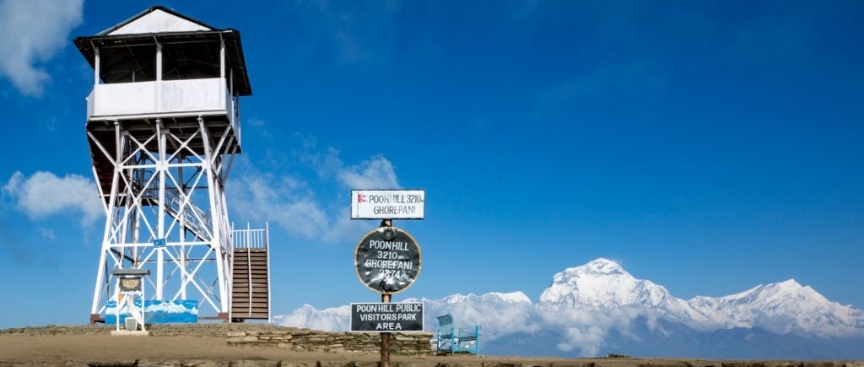
Best time for Poon Hill Trek
The Poon Hill trek is most enjoyable in the fall (September to November) and spring (March to May). The weather is normally dry and stable at some point in those seasons, with lovely vistas of the mountains and brilliant skies. Due to the slight temperatures, hiking during the day and slumbering at night time are both comfortable. The path is particularly lovable in the spring, while rhododendron blooms are plentiful. Checking the weather forecast and preparing for any changes in the climate is vital, though.
Tips for a successful Poon Hill Trek
- Most popular and the cheapest trek in Nepal.
- Along the trail, live hydrated and sip lots of water.
- Because in the middle of the night, temperatures can drop dramatically, wear warm apparel.
- Bring hiking boots of the highest caliber that provide an adequate ankle guide.
- Always take a waterproof jacket and pants in case of climate modifications.
- Always have a first aid kit and any prescribed drugs on you.
- Dress modestly and show appreciation for the customs and culture of the location.
- For ease and security, lease a porter or guide.
- Keep sufficient cash on you because a few distant locations won’t have ATMs.
- Maintain the cleanliness of the environment using no longer littering the trail.
- To prevent getting altitude sickness, cross slowly and acclimate as it should be.
Preparations for Poonhill Trek
The Poon Hill trek is rated as mild because it involves some difficult uphill and downhill terrain. To effortlessly finish the stroll, you have to have a fundamental diploma of health and stamina. Preparing for the walk should begin a minimum of one month earlier, with normal cardiovascular workouts like cycling, swimming, or walking.
Training tailor-made to the trek, such as hill strolling, stair hiking, and backpacking, is likewise useful. During the hike, it is vital to adequately hydrate and take several stops to aid in acclimatization, to save you from altitude sickness. It’s also advisable to consult a doctor before starting the hike.
4. Ghandruk and Landruk trek
Price: US$250
Location: Annapurna Region
Elevation: Ghandruk: 1,950m Landurk: 1,565m
Difficulty Level: Easy
In Nepal’s Annapurna Region, a well-favored trekking direction is the Ghandruk, and the Landruk trek is one of the cheapest Treks in Nepal. In addition to supplying exquisite Himalayan vistas, this hike offers a hazard to learn about the customs and way of life of the vicinity. Usually beginning in Nayapul, the adventure continues to Ghandruk, a picturesque Gurung village famed for its conventional architecture and tradition. The trail goes beyond Ghandruk to Landruk, another quaint metropolis with extraordinary views of the encompassing mountains.
The path then arrives at Tolka, a tiny agreement perched atop a hill with breathtaking views of the valleys and mountains beneath. The path keeps past Tolka to the tiny groups of Deurali and Pothana, where hikers can relax and refuel in teahouses and guesthouses.
The trek’s fourth day entails an ascent to Australian Camp, which affords sweeping perspectives of the Annapurna variety. Trekkers can enjoy the breathtaking perspectives of the encompassing hills and valleys while staying the night time at Australian Camp.
Traveler trek to Sarangkot, a nicely-liked hill station with breathtaking dawn and sunset perspectives of the Himalayas, on the 5th day of their journey. Trekkers descend to Pokhara after admiring the breathtaking environment, wherein they’ll unwind and enjoy the town.
All talent degrees and budgets of hikers, together with college students, beginners, and lone vacationers, can benefit from this three-night, four-day stroll. The hike gives a singular risk to take inside the Annapurna region’s breathtaking surroundings and various cultural backgrounds. Hikers can also enjoy authentic Nepali cuisine, see how the area people live their ordinary lives, and live in quaint guesthouses and teahouses alongside the path.
All things considered, the Ghandruk and Landruk trek is a high-quality preference for those who wish to take in the Annapurna vicinity’s splendor for a shorter amount of time and with much less bodily strain. For folks who are new to hiking in Nepal or have constrained time, it is a great adventure.
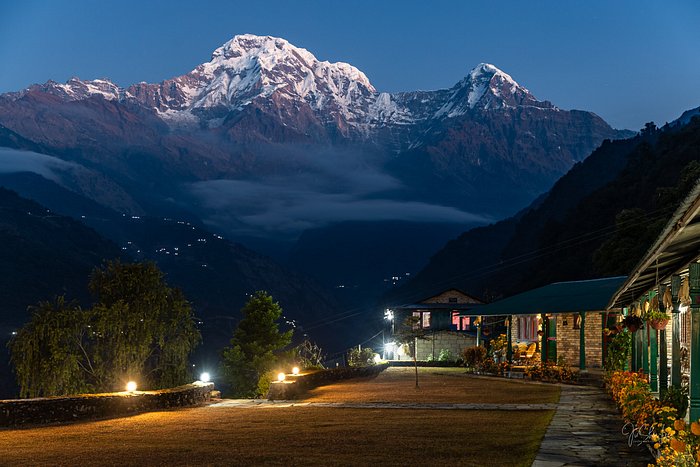
Best time for Ghandruk and Landruk trek
Trekking the Ghandruk and Landruk is most enjoyable in the spring (March to May) and fall (September to November). Trekking is good for those months because of the clear, dry, and regular weather that consists of little to no rain and snug temperatures. During these seasons, the Himalayan views are equally breathtaking, offering excellent blue skies and breathtaking sunrises and sunsets.
But in the autumn, hikers should be geared up for decreased temperatures at better elevations. Trekking is probably difficult at some stage in the summertime (June to August) due to the opportunity of rain, and at some stage in the wintry weather (December to February) because of the opportunity of severe bloodlessness and snow.
Food and Accommodation on the trek
Trekkers will discover quite some lodging alternatives alongside the Ghandruk and Landruk paths, from rustic hotels to comfortable guesthouses. Many of the hotels and guesthouses consist of hot showers, WiFi, and tidy, cushy rooms with shared bathrooms.
In terms of delicacies, the tea houses along the course offer a huge variety of nearby and foreign fare, together with momos (dumplings), pasta, pizza, and Dal Bhat, a traditional Nepalese meal together with rice, lentil soup, and vegetables. There are also alternatives for vegans and vegetarians.
Although meals are served in the inns and guesthouses, hikers are encouraged to bring their own snacks and energy bars for the trail. Trekkers have to percent a reusable water bottle and fill it with natural water, that is without difficulty on hand alongside the trail, as staying hydrated is critical to the experience.
In standard, tourists planning the Ghandruk and Landruk stroll may additionally expect easy yet comfortable accommodations and a wide variety of culinary choices.
5. Khopra Ridge Trek :
Price: US$540
Location: Annapurna Region
Elevation:3,660m
Difficulty Level: Moderate
A lesser-regarded trekking path in Nepal’s Annapurna vicinity, the Khopra Ridge Trek offers daring hikers a distinct and real experience. The ride starts with a picturesque power from Pokhara to Nayapul, observed via a hike through verdant all-right and rhododendron forests to Tadapani. The trek in the end ends in Dobato, where you may soak up expansive vistas of the Himalayas, encompassing Nilgiri, Annapurna, and Dhaulagiri among others.
The Khopra Ridge is one of the cheapest Treks in Nepal, which affords excellent perspectives of the Dhaulagiri and Annapurna mountain tiers and is the trek’s subsequent spotlight. Another choice is to go to the four,660-meter-excessive Khayer Lake, a peaceful and respected body of water.
The journey also ends in the old-fashioned village of Swanta, in which you may get a taste of the customs and traditions of the region.
Trekkers with a reasonable degree of fitness can tackle the intermediate Khopra Ridge Trek. Trekkers prefer to undertake this stroll in the fall (September to November) and spring (March to May) when the weather is pleasant, and the clear skies offer breathtaking vistas of the mountains.
Hiring a knowledgeable manual is cautioned in case you need to get the most out of your Khopra Ridge Trek. They can come up with insightful data on the history, customs, and lifestyle of the region. Along the route, you may live in teahouses and accommodations and consume traditional Nepalese cuisine including dal bhat, momos, and chow mein. Remember to convey alongside warm clothing, a very good pair of hiking boots, and every other thing you’ll want for the journey.
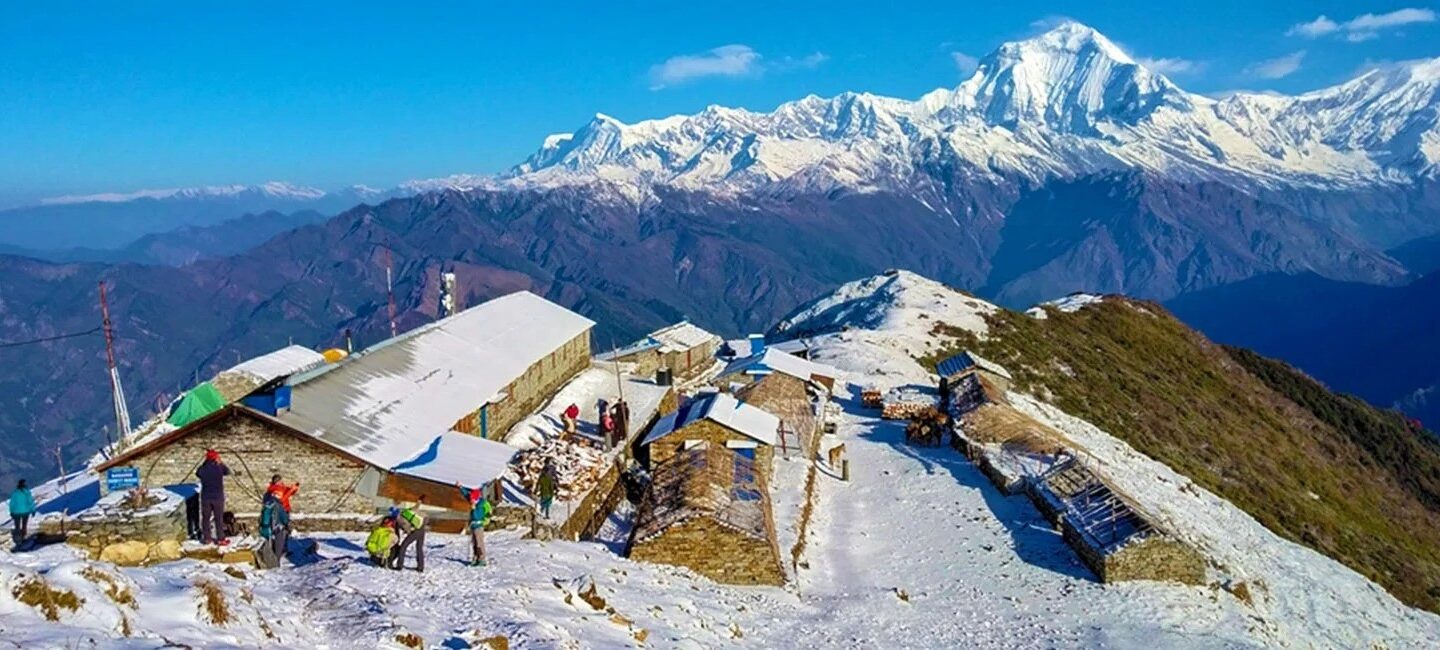
Best time for the trek
The seasons of spring (March to May) and fall (September to November) are perfect for the Khopra Ridge Trek.
Rhododendrons are in full bloom and the climate is slight in the spring, which makes for a cute trekking revel in. The nearby mountains are fantastically seen because of the clear skies.
The climate is likewise dry and moderate for the duration of the fall, with a shiny sky and precise visibility. Trekkers specifically like the fall because of the active surroundings in the course of the Dashain and Tihar celebrations.
With clear skies and comfortable temperatures, these seasons provide the perfect hiking climate. Heavy rains at some point during the monsoon season (June to August) cause the trails to become slick and hard to tour on. Winter (December to February) brings low temperatures and masses of snow, which in positive places makes trekking risky and difficult.
Conclusion
Trekkers of all skill levels can find a plethora of amazing trekking experiences in Nepal. Nepal has something to enthrall every trekking enthusiast, from the fabled trek to Everest Base Camp, which winds through the shadow of the world’s tallest peak, to the enchanting Annapurna Circuit, which showcases diverse terrain and stunning vistas, as well as lesser-known (but no less spectacular) hiking trails.

